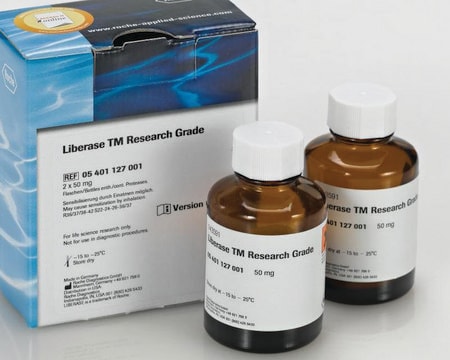04536282001
Roche
DNase I recombinant
grade I, from bovine pancreas, expressed in Pichia pastoris
About This Item
Recommended Products
biological source
bovine pancreas
Quality Level
recombinant
expressed in Pichia pastoris
form
lyophilized
specific activity
(>10,000 U/bottle according to Kunitz (+25°C; DNA as substrate).)
mol wt
39 kDa
packaging
pkg of 2 × 10,000 U
manufacturer/tradename
Roche
concentration
≥70-90%
technique(s)
protein extraction: suitable
color
white to light yellow
solubility
water: soluble
suitability
suitable for molecular biology
NCBI accession no.
UniProt accession no.
application(s)
sample preparation
foreign activity
Proteases, none detected
RNase, none detected
storage temp.
2-8°C
Gene Information
bovine ... DNASE1(282217)
General description
Activity: 10,000U/bottle according to Kunitz (+25°C; DNA as substrate).
Unit definition: One unit is the enzyme activity that causes an increase in the absorbance of 0.001 per minutes under assay conditions.
Application
- DNase I, recombinant, grade I is used for:Eliminating DNA during protein isolation procedures
- Analysis of chromatin structure
- Eliminating DNA during sample preparation
Features and Benefits
Lyophilizate
Unit Definition
Assay mixture: Calf thymus DNA (100 μg) is incubated with 20 to 50 U DNase I at +25 °C.
The increase in absorbance is measured at 260 nm.
Information Note: These conditions are used for the determination of activity,according to Kunitz, since the Kunitz assay results in high reproducibility and sensitivity. When using this enzyme for normal experimental purposes, Roche recommends using incubation buffers that are appropriate for a given application, e.g., as mentioned in the standard literature (Sambrook et al., Curr. Prot. Mol. Biol., etc.).
Preparation Note
Storage conditions (working solution): Long-term Storage of the Dissolved Enzyme
The solvent generally recommended for DNase I is water. When DNase I is reconstituted in water, the solution can be kept for 2 days at 2 to 8 °C and for 1 month at -15 to -20 °C. For best results, prepare appropriate aliquots and avoid repeated freezing and thawing. However, for long-term storage, carefully dissolve DNase I in one of the buffers listed below. In buffer 1, the enzyme will be stable for several weeks. The enzyme will be stable for at least 18 months if it is dissolved in buffer 2, 3, or 4 and stored at the recommended temperatures.
Information note: Do not vortex the enzyme while dissolving!
Buffer 1: 20 mM Tris-HCl, 20 mM MgCl2, 5 mM CaCl2, 0.1 mM dithioerythritol, 0.1 mM EDTA, 50% (v/v) glycerol, pH 8. Store this solution at -15 to-25 °C; it will not freeze at this temperature and will be stable for several weeks.
Buffer 2: 20 mM Tris-HCl, 50 mM NaCl, 1 mM dithioerythritol, 100 μg/mL BSA, 50% glycerol (v/v), pH 7.6. Store this solution at -15 to -25 °C for up to 18 months; it will not freeze at this temperature.
Buffer 3: 20 mM Tris-HCl, 1 mM MgCl2, 50% (w/v) glycerol, pH 7.5. Store this solution at -15 to -25 °C for up to 18 months; it will not freeze at this temperature.
Buffer 4: 20 mM Tris-HCl, 1 mM MgCl2, pH 7.5. Aliquot in appropriate amounts (e.g., 10 μl), freeze the aliquots quickly on dry ice, and store at -60 °C or below for up to 18 months. Thaw only the amount needed for each experiment. Do not refreeze. Discard any leftover thawed solution.
Storage and Stability
Other Notes
Signal Word
Danger
Hazard Statements
Precautionary Statements
Hazard Classifications
Resp. Sens. 1 - Skin Sens. 1
Storage Class Code
11 - Combustible Solids
WGK
WGK 1
Flash Point(F)
does not flash
Flash Point(C)
does not flash
Choose from one of the most recent versions:
Already Own This Product?
Find documentation for the products that you have recently purchased in the Document Library.
Customers Also Viewed
Our team of scientists has experience in all areas of research including Life Science, Material Science, Chemical Synthesis, Chromatography, Analytical and many others.
Contact Technical Service











